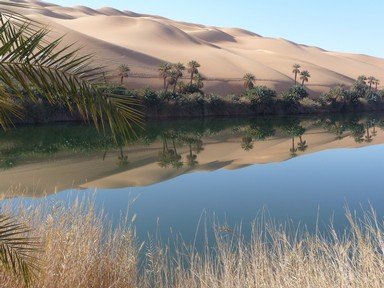7. The "Marines' Hymn" starts with these lines:
"From the Halls of Montezuma
To the shores of Tripoli"
During which war did US Marines first fight on the shores of Tripoli?
From Quiz Libya - Crossroads of History
Answer:
First Barbary War
Throughout its history, Tripoli has been more than just a city. During the time period of Barbary Coast piracy, Tripoli, or more accurately Tripolitania (aka the Kingdom of Tripoli), was one of three Barbary States, the other two being Algiers and Tunis. The Pasha of Tripoli, Pasha Yusuf Karamanli, demanded an increase in tribute from the US to protect its ships from the pirates but the US refused. The First Barbary War (1801-1805) resulted although Algiers and Tunis were not involved. The activities of the navy included blockading most of the Libyan coast from 1801 through 1805. In 1804, the Battle of Tripoli Harbor was fought. In this battle, US Marines used a captured enemy sailing boat to get close enough to a captured American frigate to recapture and destroy it. The action created one of America's first military heroes since the Revolutionary War, Lt. Stephen Decatur, who led the mission. The battle was largely indecisive. In 1805, at the Battle of Derne the US prevailed and the war ended. Derne, or Derna, is located in eastern Libya in Cyrenaica and was the seat of one of the wealthiest provinces in the Kingdom of Tripoli. Today it is a city of about 80,000 people and is famous for its Ottoman architecture.
This was the first major action for either the US Navy or the Marines since independence. A second Barbary War was fought in 1815 but this time the target was Algiers. These two wars ended the need for Americans to pay tribute to stop piracy.
Tripoli was founded in the 7th century BCE by the Phoenicians under the name Oea most likely because of its natural harbor. From there it passed through the centuries to the Greeks, Carthaginians, Romans, Arab Muslims, Spanish, Ottoman Turks, and Italians. Since its inception the city has always played a large role in the region. It is the largest city in Libya and home to 1.8 million people. During the 2011 Libyan Civil War it was the stronghold of Gaddafi until it fell quickly on August 21st. With its fall, a rebel victory was ensured even though the war would not end until Sirte fell on October 20th.
"The Halls of Montezuma" refers to the Mexican-American War (1847) and the capture of Chapultepec Castle by the Marines in the Battle of Chapultepec.





 Top 10% Rated Quiz,
Top 10% Rated Quiz,
 A Well Rated Quiz
A Well Rated Quiz